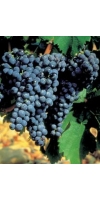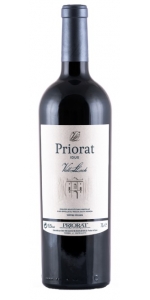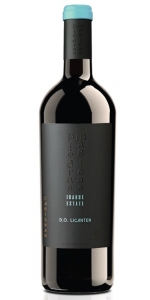Carignan

Carignan is a red wine grape that most believe originated in Spain in the Aragon region. Carignan was later transplanted to Sardinia, Italy, Algeria, France, and the majority of the New World. Carignan was considered to be one of the predominant grapes that was responsible for France’s wine lake. Wine regions and vineyards in California rarely use Carignan to produce varietal wines, but some old vines do exist. Carignan is used in Australia as the main component for blended wines. Carignan was crossed with Cabernet Sauvignon producing Ruby Cabernet. Because of its upright growth pattern, it can be grown without the use of a trellis. Historically a component of the neighboring region Rioja, Carignan gained popularity in Algeria and was the leading export to France. When Algeria gained independence in 1962, the Carignan wine supply was cut off and wine growers began to plant Carignan vines in southern France. Carignane became the most widely planted vine in France in 1988 with 167,000 hectares of Carignan. The Carignan vine can produce large yields, nearly 11 tons per acre, and a high sensitivity to grape worms, downy mildew, powdery mildew, and rot. The Carignan grape buds late and ripens in a warm climate, which is mandatory for full ripeness.
Celler Vall Llach Idus
Since its founding in the early 1990s by celebrated singer Lluís Llach and notary Enric Costa, Celler Vall Llach has committed itself to rigorous quality standards. Located in the tiny mountain town of Porrera in the D.O.Q. Priorat, the winery is now headed by Enric’s son Albert as winemaker, general manager and co-owner.
The magnificent century-old estate vineyards boast 60- to 90-year-old Cariñena and Garnacha vines as well as newer plantings of Garnacha, Cabernet Sauvignon, Merlot and Syrah that add complexity to Vall Llach’s range of widely acclaimed wines. Priorat’s notoriously stingy llicorella (fractured black slate) hillsides produce extremely low yields of intensely flavored grapes.
The Celler makes this wine from grapes from very old vines, some of which are centuries old, belonging to selected farms, owned by farmers who have been collaborating with us since our foundation. From the Cellar, we make a thorough follow-up of each of the production processes. And this collaboration with the farmers, who bring us inherited traditions and customs, allows Celler Vall Llach to identify this wine with the effort and uniqueness of the cultivation of these lands. Idus is a local wine. AGING The wine was transferred to 225 and 300 litre second wine barrels of light- and medium-toasted fine grained new French oak. The wine was moved once during the ageing period of 14 months
Review:
Made with Carignan and Garnacha, this deep-violet-colored wine has a bouquet of dark plum, purple fig, clove and lavender. It is smooth in the mouth, with flavors of black currant, blackberry, dark chocolate, anisette and violet. It offers bold acidity, plush tannins and a lengthy finish.
-Wine Enthusiast 95 Points
Cote 125 Corbieres Rouge is made from 50% Carignan, 35% Grenache, 15% Syrah.
Brambly berry, cherry and raspberry, spices, black pepper … all are present in this authentic French country wine. There are also some aromas of Garrigue (Rosemary, thyme and lavender) giving a minty, herbal notes, that are quite refreshing as well.
The wine is a perfect match with a nice rosemary marinated roasted lamb.
Vina La Ronciere 'Piedras Magicas' Idahue Estate Carignan is made from 100 percent Carignan.
Piedras Mágicas is hand-selected from small blocks in the Idahue vineyard based on specific soil compositions and microclimate characteristics. The final blend is comprised mainly of Carignan and complemented by other varieties in small proportions determined by vintage.
Located 15 miles from the Pacific Ocean, La Ronciere’s ambitious 500 acre Idahue Estate is their vision for the future. Prevailing coastal breezes, abundant sunshine, and rolling hills of ancient soils culminate in a privileged climatic and geological landscape. Years of research and a forward-looking approach drove the successful effort that saw Licanten granted D.O. status in 2018.
This wine displays a deep red color and offers aromas of black- berry, plum and floral notes. A complex palate of black fruits combine with pleasing notes of vanilla. Its volume and silkiness stand out. Juicy tannins and persistent acidity retains balance and elegance.
Review:
This wine displays a deep red color and offers aromas of black-berry, plum and floral notes. A complex palate of black fruits combine with pleasing notes of vanilla. Its volume and silkiness stand out. Juicy tannins and persistent acidity retains balance and elegance
-Tim Atkin MW 94 Points
- back
Selected Options
Grape Types
Categories
Pricing
Countries
Regions
Grape Types
Wineries
Organic/Free Shipping
The 2017 was a very different year to 2016 in terms of the viticultural conditions and it was interesting to watch the progression of the wine and scrutinize its quality as it developed over its first two winters. Whereas 2016 had a very mild winter and exceptionally hot summer, this was compensated by abundant winter and spring rainfall. Conversely, 2017 was warm and drythroughout, although summer temperatures were closer to average, whichproved to be a very significant factor allowing for complete, balancedripening.
It is rare to see such tremendous depth and intensity in color as this winedisplays. The freshness of the floral aromas is very attractive with adominance of rockrose, a flower that grows wild around the hills of Senhorada Ribeira. On the palate, it is exceptionally full-bodied, rich andpowerful with black fruit coming to the fore. Gorgeous, ripe fruit isbalanced by the fine tannin structure. On the finish, it is typically Dow,austere and somewhat drier than many other ports. The intense fruit flavors linger long on the palate.
Dow’s Vintage Ports are only produced in years of exceptional quality and represent only a very small part of the total company’s production in that year. On average only two or three times every ten years are the weather conditions sufficiently good to allow for the making of Dow’s Vintage Port.
Throughout the 19th and 20th centuries, Dow’s Vintage Ports have been landmark wines in virtually every great year, consistently setting the standards amongst all Port houses. Vintage Ports such as the remarkable Dow 1896, the 1927, 1945, 1955, 1963, 1966, 1970, 1980 and the Dow 1994 are all legends in the history of this great wine. These Ports are still magnificent today, even when 50 or over 100 years old. Few wines can claim this quality and this pedigree.
Dow's Vintage Ports are drawn from the companies' finest vineyards; Quinta do Bomfim and Quinta de Senhora da Ribeira. Each property contributes to the Dow’s unique and distinctive style. When young, Dow’s Vintage Ports are purple-black, austere, complex and intensely concentrated, full-bodied and balanced with very fine peppery tannins.
Over the centuries, the Dow winemakers have evolved a style that suits the house’s key vineyards; fermentations are a little longer, resulting in a drier Port Wine that has become the hallmark of Dow’s. Abundant fruit flavours with hints of ripe blackberries, give elegance and poise to Dow’s. The nose is deep and powerful with strong overtones of violets when young, these mature into fine cinnamon and rose-tea aromas with age. The very high percentage of Touriga Franca and Touriga Nacional planted on the vineyards result in the powerful structure and aging potential of Dow’s Vintage Ports
Dow’s Ports avoid an over-rich style and requires a very high degree of skill in wine making and great experience in selecting the finest wines of each year and each vineyard. These wines are aged in seasoned oak casks for some 18 months and are bottled without any filtration or fining whatsoever.
Dow Vintage Ports can be enjoyed when vibrant and young or they can be allowed to age for many years in bottle into a soft and delicate wine of velvet-like elegance.
In the 1920’s, the celebrated Oxford Professor George Saintsbury underlined Dow’s outstanding reputation when he wrote in his famous ‘Notes on a Cellarbook’ (first published in 1920), “There is no shipper’s wine that I have found better than the best of Dow’s 1878 and 1890 especially.”
James Suckling, one of today’s leading authorities on Vintage Port was equally impressed by another legendary wine - the Dow’s 1896 - “The ancient {1896} Port still had an amazing ruby colour with a garnet edge, and it smelled of raisins, black pepper and berries. It was full-bodied, with masses of fruit intertwined with layers of velvety tannins. It was superb.” In 1998, when this wine was 102 years old, he awarded this Port an exceptional 98 points.
Review:
Based on fruit from the predominantly south-facing Quinta do Bomfim in the Cima Corgo and Quinta Senhora da Ribeira in the Douro Superior, with Touriga Nacional and Touriga Franca making up 80% of the blend. This is opaque and closed in but powerfully ripe with underlying pure berry fruit. It's seemingly quite introverted compared to some of its peers at this stage, but it's still full, rich and opulent on the palate. It also shows the latent power of the vintage, made as it is in a slightly drier style (3.4 Baumé), with lovely minty fruit and full, ripe sinewy tannins all the way through the finish. Long and lithe, and very fine.
-Decanter 97 Points
A dense, thickly textured version, dripping with warm salted licorice, tar and açaí paste notes, while plum and blueberry pâte de fruit, chai spice and chocolate elements fill in behind. Lots of brambly grip flows underneath. Shows a very sappy feel on the finish. Best from 2035 through 2055. 5,250 cases made, 1,092 cases imported
-Wine Spectator 96 Points
This is a dry while also floral wine, perfumed and enticing with its juicy acidity. At the same time, the structure is very present, showing power and dark black fruits. The balance is coming together with the rich fruits and tannins melding into one. Drink from 2028. ROGER VOSS
-Wine Enthusiast 96 Points
Deep dark ruby garnet, opaque core, violet reflections, delicate brightening of the edges. Black wildberry jam underlaid with delicate herbs and spices, tobacco nuances, hints of blueberry jam and elderberries, schisty notes. Powerful, full-bodied, sweetness present, carrying tannins, dark nougat in the finish, very good length, an imperious style, built for a long life.
Falstaff 98 Points
Ancien Pinot Noir Carneros is made from 100 percent Pinot Noir.
Pinot Noir Carneros comes entirely from the Toyon Vineyard, located in the Napa side of Carneros. This vineyard was originally planted for Ancien Wines in 1998 with cuttings tracing back to the Swan estate in Sonoma County and Dijon 115 - followed by cuttings from Ed Penhoet’s vineyard in Carmel Valley. Ed’s selection from River Selection is a story into itself, and is sometimes referred as “Pisoni Clone” since Gary Pisoni took cuttings from the vineyard in the early ‘80s.
Baking spice sings in an endless symphony with wild berry notes, complemented by characteristic Carneros notes of cola. Juicy cherry notes grace the palate and combine seamlessly with anise and hibiscus, ending on a savory note. The palate is round and full of textural, mouth-coating tannins balanced by a bright acidity. Broad chewy tannins, earthy spices and minerality complement the fruit and exotic floral notes of this wine. The palate of this delicious wine will continue to develop in opulence over years of aging, revealing even darker layers and an increasingly smooth texture.







